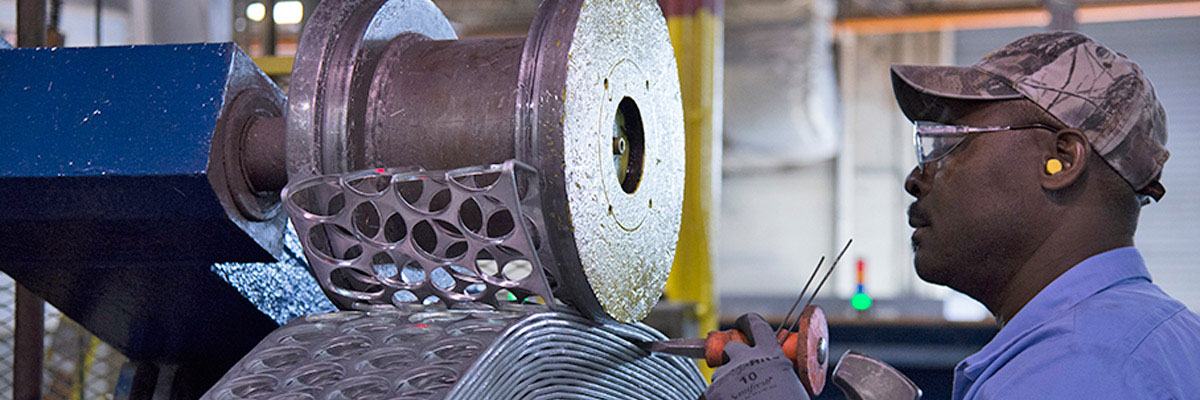
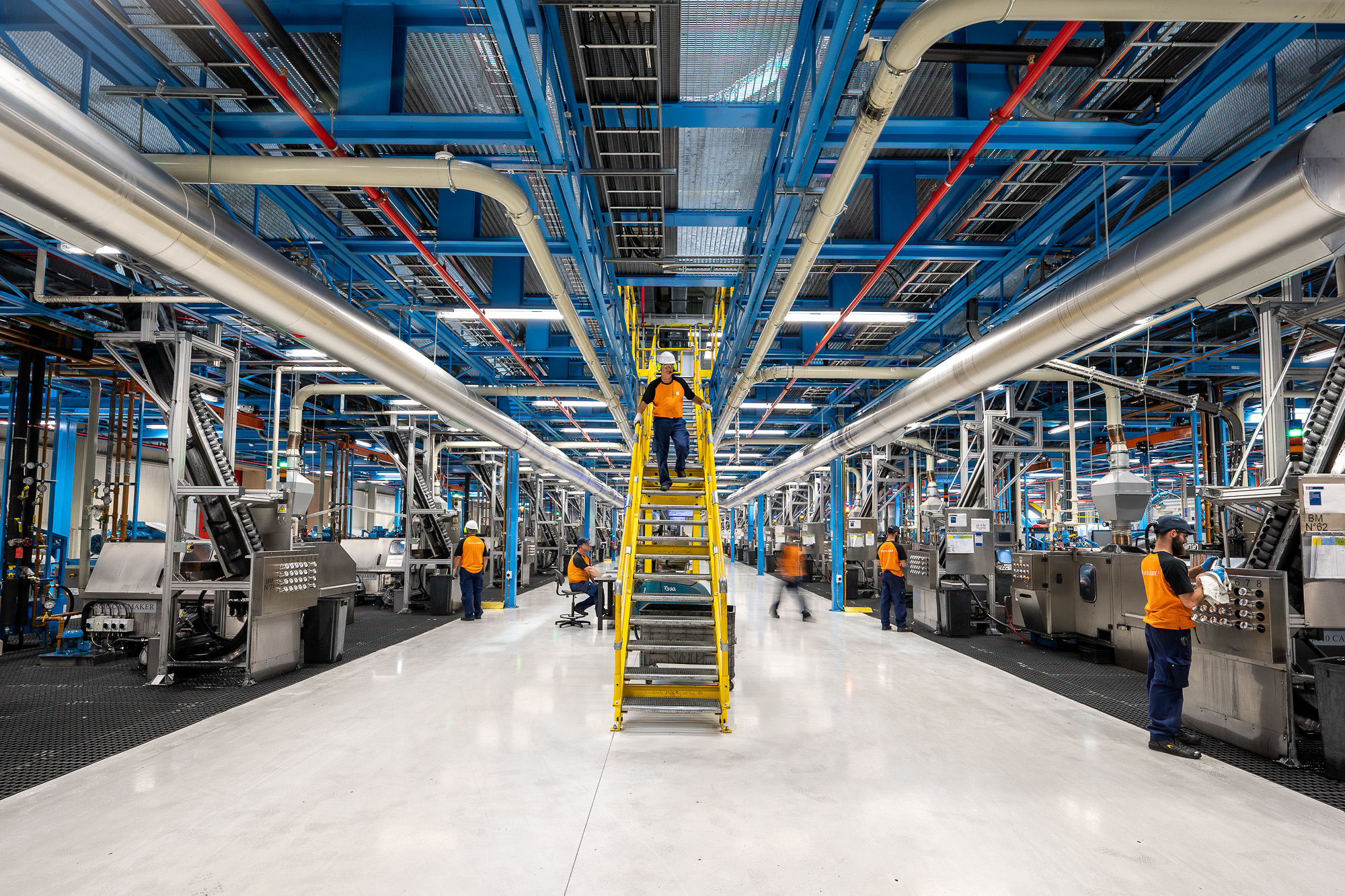
Resource Efficiency
Sustainability is embedded in our manufacturing operations and is a lever of operational excellence. We recognize the impact our operations have on the environment and the local communities where we operate and are committed to continuous efficiency improvements. We introduce innovative processes and technologies that improve our safety track record, reduce energy and water consumption, cut greenhouse gas emissions and divert more waste to beneficial use.
Employee engagement and commitment to sustainability are key to our operational success. To make sustainability more tangible for our employees, we introduced the “Big 6” concept in 2008 to focus the attention of Ball employees on the six most significant sustainability metrics in our operations.
Around the world, each Ball plant is accountable for these "Big 6" metrics and commits to annual goals as part of our strategic planning process. Each plant's performance is tracked monthly and reported to regional leadership teams. The businesses report their goal progress to corporate once each quarter and Ball's Sustainability Steering Committee reviews progress twice a year. To drive accountability and continuous improvement, goal achievement progress is also built into performance appraisals for plant management and operations leadership.
All of our plants utilize formal safety and environmental management systems. Since 1995, these systems have improved our safety and environmental performance by allowing us to monitor and manage our impacts and proactively implement corresponding compliance strategies. As of June 2023, 90% of Ball's manufacturing plants are ISO 45001 and ISO 14001 certified. Ball’s global environmental policy describes our expectations for managing and continually reducing our environmental impacts.
LIGHTWEIGHTING
In every step—from concept, design, manufacturing and filling to delivery of the final product to the consumer—innovation helps us identify and drive profitable growth. We work closely with our customers to understand their businesses and consumer demand, as well as the challenges and trends they encounter so we can develop industry-leading packaging solutions and graphics to help them grow their businesses.
Often invisible to the outside world, many of Ball’s successful product and process innovations—such as weight optimization of our cans or increasing manufacturing speeds—provide significant environmental and economic benefits to the company, our customers and consumers. We evaluate innovations through a variety of lenses, including consumer benefits, carbon footprints, costs and the impact of new products on the recycling process.
Our intent is to make the lightest metal containers possible while meeting the performance requirements of our customers. Even small weight optimizations save significant amounts of metal, costs, energy and emissions when multiplied by the billions of containers that Ball produces each year. That is why weight optimization represents a major contribution to our 2030 resource efficiency goals.
Our global portfolio of STARcans is setting new standards for weight optimization. Compared to other beverage cans of the same size, it reduces weight by 3% to 8%. In 2021, we announced a new commitment to use lightweight STARcan designs in 80% of our global beverage can production by 2030. At the end of 2022, Ball’s percentage of lightweight star cans was 31%, a 10% increase from last year. As a result of these lightweighting efforts, Ball reduced aluminum consumption by over 6,200 metric tons, translating to approximately 32,680 MT of CO2e saved.
Aerosol can manufacturing technology had not changed for several decades, but this changed in 2010 when Ball started working on ReAl®, a revolutionary new aerosol can technology that offers multiple economic and environmental advantages.
Ball’s Aerosol Packaging business has developed ReAl®, a lightweight alternative to standard aluminium used in aerosol can manufacturing. The ReAl® alloy creates a can 30% lighter than a standard aluminum beverage container. When combined with low-carbon primary aluminum, this translates to a 50% carbon footprint reduction in our Re:Gen cans, compared to a standard can. In 2022, 59% of global aerosol can production was made with lightweight ReAl®, well exceeding our goal of 50% global aerosol can production by 2030.
Visit our ReAl® page to learn more about this innovative technology.
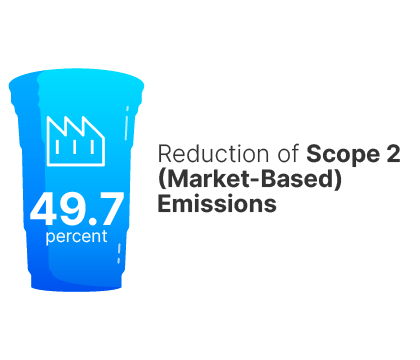
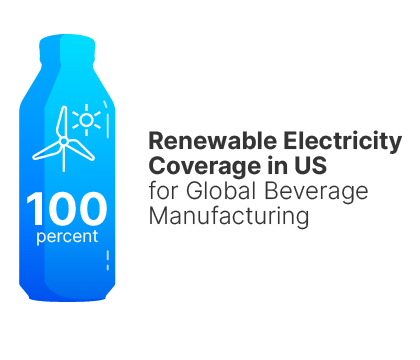
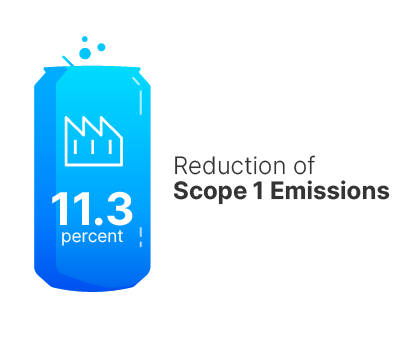
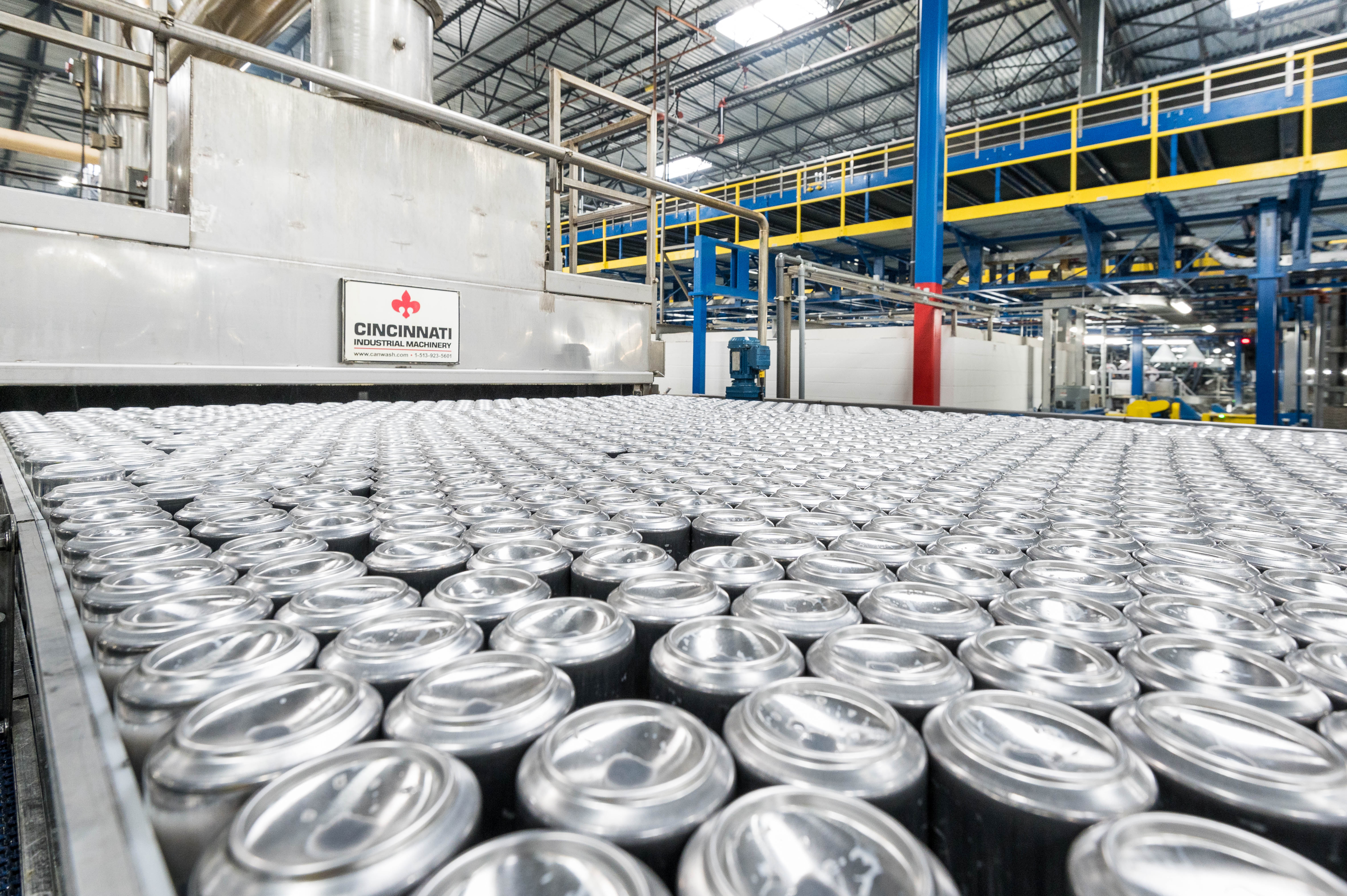
Water
Because access to fresh water is vital to consumers, our customers, our suppliers and Ball, we hold ourselves accountable for conserving and protecting water resources in our products, the communities where we operate and our entire value chain. A growing world population with greater demands for water-intensive food and energy, combined with increasing water needs and severe pollution of water resources in emerging economies, pose significant water supply constraints in some regions.
By making use of the globally recognized WRI Aqueduct tool, we have established that the majority of our packaging plants today (56%) are in low or low-to-medium water stress areas, with 20% in medium-to-high water stress areas. However, 16% are in high water stress areas, with the remaining 9% designated as extremely high water stress.WRI considers issues such as water stress, baseline depletion, interannual and seasonal variability, groundwater table decline, coastal and riverine flood risks, drought propensity, untreated wastewater, coastal eutrophication potential and the availability of drinking water.
We continue to focus on reducing water usage across our plants; however, we focus our efforts on plants where water availability is an issue for local communities or where it creates operational challenges for us. As part of our 2030 water goal, in 2021 we began developing a roadmap for water management for our beverage packaging manufacturing plants, which includes guidance on water reduction, water recycling and local watershed engagement in areas of high water stress. In 2022, Ball partnered with the 100+ Accelerator to launch a pilot program with Waterplan, which has developed a platform to measure, address, and report water-related risks to ensure organizations progress toward water security. By leveraging external tools and internal subject matter experts, we are able to monitor water risks and manage plans to further minimize those risks. This better enables Ball to maintain business continuity at our manufacturing sites around the world.
We are responsible stewards of water, using as little as possible for each product we produce. We continue implementing projects to better understand and manage regional and local water impacts. In 2022, Ball used 9.85 million cubic meters of water worldwide, primarily for forming, washing, rinsing and cooling. To ensure we have reliable data, we engaged with a third party agency to provide limited assurance in relation to our 2022 water consumption.
Ball’s most water-intensive process is washing our cans during manufacturing. On average, washers account for about two-thirds of the total water consumption in a beverage can plant. To create efficiencies, Ball’s washer process occurs in counter-current cascades to reuse water at different washing stages.
To better understand, monitor and improve our water usage, Ball continues to invest in breakthrough technologies and innovative equipment that will allow us to change how much water we use in our operations. For example, many plants are replacing traditional deionizing water filtration with reverse osmosis systems. Water that has been treated through reverse osmosis can be recirculated and re-used more easily than water that has been deionized. We also invested in wastewater treatment technologies, evaluated advanced treatment options for effluents and installed several pilot systems to enable water reuse. Additionally, we are transitioning to new washer systems that will improve water efficiency.
In several plants, we also appointed and trained local water champions. These employees analyze water data, control water-consuming equipment and drive enhancements. While our goal is to reduce water consumption as much as possible, we also must diligently monitor the quality of produced cans. If we reduce the water intake of washers too much, the quality of our cans is affected and spoilage increases.
Because water is used in many steps along the packaging value chain—whether in mining and metal manufacturing or electricity generation—as well as in the production of the products that are put into our packaging, we maintain an open dialogue with our suppliers, customers and the communities where we operate.

Waste
Material use and waste volumes are important yardsticks in evaluating the efficiency of our processes. Reducing spoilage in our manufacturing processes and recycling all metal production scrap are the most obvious ways that Ball can conserve resources and generate additional revenue. As our business continues to evolve and production volumes grow, our waste strategy remains the same—focus on systematically reducing the amount of waste generated, eliminating waste sent to landfills and increasing recycling rates.
Approximately 58% of the total waste generated by Ball is either reused or recycled. Our waste management efforts focused on increasing our waste diversion efforts through reuse, recycling and other recovery options. Our total waste diverted from disposal equated to 55,287 metric tons globally in 2023.
Because waste classifications and disposal methods vary from country to country, based on legal requirements and local infrastructure, reporting accurate waste data in a timely and consistent way throughout our global operations is a complex task. In cooperation with waste management contractors around the world, we have utilized a standardized waste data collection process globally since 2008. Ball is continuing to refine global waste classifications and further align monthly waste generation and material diversion category reporting for all manufacturing plants.
The monitoring provides insight on where the biggest opportunities exist to reduce waste and divert it from less beneficial streams like landfill and waste-to-energy. We continue to educate our employees about the benefits of recycling, provide a convenient recycling infrastructure in our facilities and cultivate a conservation mindset. Operations leaders and facility management support plant efforts and provide assistance. Since 2015, we have increased the amount of waste that is recycled and reused 55%.
By the end of 2022, 29 of our over 60 packaging manufacturing plants worldwide sent zero waste to landfill. Only 7% of the total waste Ball generated in 2022 was sent to landfills. Diverting waste from landfills is a challenge in some regions, especially when landfill costs are low or when waste must be shipped over long distances for alternative treatment options. Therefore, our long-term goal is to minimize waste sent to landfill when it is environmentally sound and economically feasible.
Since 2008, we have diverted the filter cake in our operations from landfills. Filter cake accumulates during wastewater filtration and represents the largest waste stream by weight in our aluminum beverage can plants, accounting for up to 60% of a plant’s total waste. Ball has continued to identify opportunities to divert filter cakes from the waste stream. Some recent solutions include using filter cakes for alternative daily cover on landfills and as an ingredient in cement kiln processing.

Energy
As we are driving to reach 100% renewable energy around the world, we are also improving energy efficiency at all of our manufacturing plants.
We are committed to reducing the amount of energy required to produce each beverage can in our manufacturing plants by 30% during this decade. This primarily means cutting back on our use of electricity and natural gas. Since our Global Beverage Packaging business accounts for most of our energy consumption, much of our efforts are focused in this business. Given we have plans in place to eliminate all GHG emissions associated with electricity by 2030 through the use of 100% renewable electricity, our attention is now on reducing the use of natural gas.
Every Ball plant commits to annual energy goals supported by detailed action plans. Real-time energy information systems provide visibility into our operations at the equipment level so we can better understand, manage, report on and benchmark the performance of energy-consuming processes. All of Ball plants have formal energy management systems at year-end 2020.
To significantly and cost effectively reduce our energy consumption, we follow a global energy strategy that addresses energy supply and demand and requires the consideration of energy efficiency when making investment decisions.
To further accelerate our progress, in 2021 we continued to invest in energy monitoring across our global network of beverage can manufacturing plants. In order for Ball to harness the power of this data, we began implementing a software solution with Artificial Intelligence (AI) to make predictive, accurate, and actionable decisions to optimize our roadmap on reducing energy and water use, carbon emissions and utility costs. This system will not only provide our plant operators with real-time insights into improving energy efficiency on a day-to-day basis, but will allow our regional engineering and operations teams to optimize future investments while meeting our sustainability goals.
We have also began exploring the potential for electrification of ovens used in our can making process that traditionally use natural gas – including working with key suppliers to begin testing electric heating options at our innovation center in Colorado. Through electrification of thermal energy loads and the use of renewable electricity, there is great potential to reduce fossil fuel use and Scope 1 GHG emissions. However, this can increase our demand for electricity which further informs our projections for renewable energy needs.
The majority of our energy consumption comes from air compressors and ovens in our plants. In a beverage can plant, air compressors consume between 20% and 30% of the electricity. We conduct audits of our compressed air systems and optimize performance by reducing system pressure, minimizing wasteful air use and leaks, and decreasing manufacturing equipment demand. We continued to install more efficient compressors and connected additional equipment to low-pressure systems during the reporting period. At the end of 2019, 59% of our beverage can plants operated dual-air systems that supply equipment with either high- or low-pressure air. Compared to traditional systems that rely only on high pressure, low pressure compressed air is 22% more energy efficient than high pressure air, and also results in less energy loss through artificial demand. In 2019 a global team of regional staff developed a compressed air global standard for new construction projects to ensure future energy efficiency.
Below are a few examples of 2020 energy efficiency efforts: In 2020, air compressor replacements in our Gelsenkirchen, Germany plant and Nogara, Italy plant will save a combined 4,000 megawatt hours of electricity annually. Our Williamsburg, U.S., plant completed an air compressor audit in 2020 which resulted in several action items whose fixes resulted in nearly 900 megawatt hours of electricity savings.
Within our operations, ovens are used to evaporate water from cans after being washed and to cure external and internal coatings. Ovens account for up to 75% of a beverage can plant’s natural gas usage and up to 20% of its electricity usage. Through oven audits, low-cost optimization projects, and increased employee awareness of oven energy use and associated costs, we have realized natural gas efficiency gains in our can businesses of 4.7% between 2015 and 2020. A 2020 burner replacement program in our Buenos Aires, Argentina, Três Rios, Santa Cruz and Recife, Brazil can plants led to a combined annual savings of 4,730 MMBtu, equal to approximately 1,386 megawatt hours.
Heating, ventilation and air conditioning (HVAC) control during the heating season is another energy efficiency opportunity. Central control systems and higher awareness of HVAC-related energy usage and costs are driving progress. We identify optimal temperatures for different areas within a plant and educate employees on how they can achieve these temperatures with the lowest energy input. Installing heat curtains, for example, reduces heat or cooling loss.
During the reporting period, lighting continued to be a priority for our energy engineers. While it is crucial to provide proper lighting to keep our employees safe and allow them to effectively execute their jobs, lights do not need to be continually at full power. Every Ball plant changed some lighting to LED and several underwent complete conversions. We include adaptive lighting control options to further increase efficiency by matching the light levels to occupancy and daylight availability. Compared to conventional lighting, a completely converted LED plant with both lights and respective controls saves about 75% lighting electricity, with 55% of this savings from the LED and 45% from the controls. In addition to LED lighting, we are installing skylights and additional windows in some of our facilities to better utilize daylight.
A team effort is required to achieve our plant energy reduction goals. That is why several facilities established formal voluntary energy conservation or broader sustainability teams. Ball's metal beverage packaging plant in Fort Atkinson, Wisconsin, has a multi-year track record of engaging its employees in energy conservation efforts and improving energy efficiency. Between 2010 and 2021, the plant improved its electricity efficiency by 20%. And the team in Fort Atkinson continues to develop and test new ideas to further maximize the value of our existing businesses.
Ball’s management team is committed to energy improvements and invested $7.8 million in energy-saving projects in 2020. These measures will generate estimated electricity savings of 34.2 million kilowatt hours and natural gas savings of approximately 23.1 million kilowatt hours per year, exceeding the annual energy consumption of over 5,000 average U.S. households.
BIODIVERSITY
Although Ball facilities are typically located in industrial zoning sites, as part of the ASI certification process, we have begun undergoing an internal biodiversity audit of several manufacturing facilities. Examples below describe efforts underway across our regions.
Click to download an overview of our South American biodiversity efforts in Spanish, Portuguese or English.
Twenty-two acres of land on our 56-acre plant site in Rome, Georgia, have been certified as a “Wildlife at Work” site by the Wildlife Habitat Council – a nonprofit, non-lobbying group of corporations, conservation organizations and individuals dedicated to enhancing and restoring wildlife habitat. Rome employees have built nesting structures on the land to enhance habitat for birds of prey. They also constructed wildflower gardens to improve habitat for native pollinators.
Another example of how Ball supports biodiversity is from our Bierne, France, plant. When the plant built a new watershed basin for rainwater, employees developed a biotope on top of it where numerous animals and regional plants settled in the meantime. Employees use the grounds for their breaks and every visitor can learn about the special habitat when onsite. This initiative has been rewarded with the “Environmental Performance Award” by the regional chamber of commerce and the trophy of the best environmental performance by the north regional council and the French environmental ministry.
Using the Integrated Biodiversity Assessment Tool (IBAT) developed by the UN Environment World Conservation Monitoring Centre and Geospatial Data Management System (SIGEO) tool developed by Chico Mendes Biodiversity Conservation Institute (ICMBio), we determined none of the Ball facilities in South America are located in nationally protected areas. An example of how Ball BPSA supports biodiversity is by keeping a reforestation area with native species at our plant site Três Rios, Brazil.
